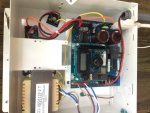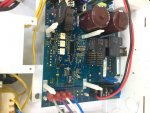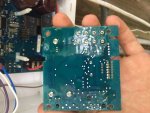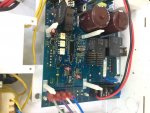Good evening, all!
I converted my pool to a salt water system a month ago. We moved into the house we just bought, and have been renovating the pool system. I replaced the pool motor since it was frozen, and added the SWG system (Hayward Aquarite Goldline T-Cell-3). It worked great for the last month or so. Last week, I went to check on the generator after work (my wife is home during the day, so I try to start it every morning before work and have her turn it off after 8 hrs). We had had a lot of hot afternoons combined with a lot of rain, so I'd been letting stay on longer to get our chlorine level up to where it should be. I also had just started to implement stabilizer a week ago as well, and the first couple days went well.
When I checked on the generator, the pump was still running, but the generator was completely off. No LCD display, no lights at all. I checked the power with my mulitimeter, still around 240 volts, as it normally is. I read up on it, and found out that the resistor (quarter sized black thing) is a common issue, as well as the 20amp fuse. Replaced the fuse with a brand new one that I tested with both a fuse tester and my multimeter, no luck. Moved on to the resistor. I tested it, resistance was low: around .7 instead of 2 ohms. I got the replacement piece today from Amazon (I did try the other site as well, but longer shipping). Soldered the new resistor on, and it seemed ok. I checked it with the multimeter, it sits right at 2 ohms. The generator still appears to have no power. I checked and rechecked my wires, and none seemed to have bad contacts. I tried the voltage again, still 240. Tried the fuse again, still ok. I also have not found any burn points on the circuit board. Does anyone have any ideas what is going wrong?? Brand new system! Is there anywhere else on the board I can test to see where the failure is?
I have no idea what to do! I truly appreciate anyone being able to get back to me. I shouldn't have had this issue only a month after buying this brand new system!!
tl;dr: month old, brand new SWG, no power after heat wave/thunderstorms. Fuse and resistor are fine, no effect after replacing.
The forum won't let me add pictures, so please see below... And I'll try to reply to this post with pictures.
Model looks like this:
Amazon.com: Hayward GLX-PCB-RITE Replacement Main PCB Printed Circuit Board for Hayward Goldline AquaRite Salt Chlorination Systems: Patio, Lawn Garden
Amazon.com: Hayward GLX-PCB-DSP Display PCB Replacement for Select Hayward Salt Chlorine Generators: Patio, Lawn Garden
I converted my pool to a salt water system a month ago. We moved into the house we just bought, and have been renovating the pool system. I replaced the pool motor since it was frozen, and added the SWG system (Hayward Aquarite Goldline T-Cell-3). It worked great for the last month or so. Last week, I went to check on the generator after work (my wife is home during the day, so I try to start it every morning before work and have her turn it off after 8 hrs). We had had a lot of hot afternoons combined with a lot of rain, so I'd been letting stay on longer to get our chlorine level up to where it should be. I also had just started to implement stabilizer a week ago as well, and the first couple days went well.
When I checked on the generator, the pump was still running, but the generator was completely off. No LCD display, no lights at all. I checked the power with my mulitimeter, still around 240 volts, as it normally is. I read up on it, and found out that the resistor (quarter sized black thing) is a common issue, as well as the 20amp fuse. Replaced the fuse with a brand new one that I tested with both a fuse tester and my multimeter, no luck. Moved on to the resistor. I tested it, resistance was low: around .7 instead of 2 ohms. I got the replacement piece today from Amazon (I did try the other site as well, but longer shipping). Soldered the new resistor on, and it seemed ok. I checked it with the multimeter, it sits right at 2 ohms. The generator still appears to have no power. I checked and rechecked my wires, and none seemed to have bad contacts. I tried the voltage again, still 240. Tried the fuse again, still ok. I also have not found any burn points on the circuit board. Does anyone have any ideas what is going wrong?? Brand new system! Is there anywhere else on the board I can test to see where the failure is?
I have no idea what to do! I truly appreciate anyone being able to get back to me. I shouldn't have had this issue only a month after buying this brand new system!!
tl;dr: month old, brand new SWG, no power after heat wave/thunderstorms. Fuse and resistor are fine, no effect after replacing.
The forum won't let me add pictures, so please see below... And I'll try to reply to this post with pictures.
Model looks like this:
Amazon.com: Hayward GLX-PCB-RITE Replacement Main PCB Printed Circuit Board for Hayward Goldline AquaRite Salt Chlorination Systems: Patio, Lawn Garden
Amazon.com: Hayward GLX-PCB-DSP Display PCB Replacement for Select Hayward Salt Chlorine Generators: Patio, Lawn Garden





